Why Make Lonzo
Like many traditional Italian salumi, Lonzo is simple. It takes time and little planning, but the result can be epic, tasty, and unique. Lonzo is a dry cured craft meat spiced and offers leaner cured meat than other traditional Italian classics.
This type of salumi salt dry cured meat (full guide here) can be eaten often; it’s not overpowering or rich. It’s a classic antipasti/charcuterie board for every occasion.
Lonzo is often a leaner cut, although it can be trimmed to your preference. It consists mainly of meat with a moon-shaped streak of fat on the exterior.
I’ve found that Lonzo is quicker to dry to a target weight than many other traditional salumi (salumi vs. salami article) muscle cuts because it is less fatty.
I’ve only seen Lonzo/Lonzino on antipasti plates in Italy. I’ve not seen it used in cooking. As a preserved dry-cured whole muscle meat, once curing and drying is completed, Lonzo can last for many months, potentially years, if stored.
Lonzo is more often a Northern Italian variety (i.e. Emilia-Romagna, Marche). Lonzo is more associated with central (Tuscany, Umbria) and southern Italy. Lonzo is a different variation of salt-cured loin in Spain.
I started making Lonzo with wild meats other than pork many years ago. Since then, we have used whole pigs and regularly made Lomo, Lonza, and Lonzino.
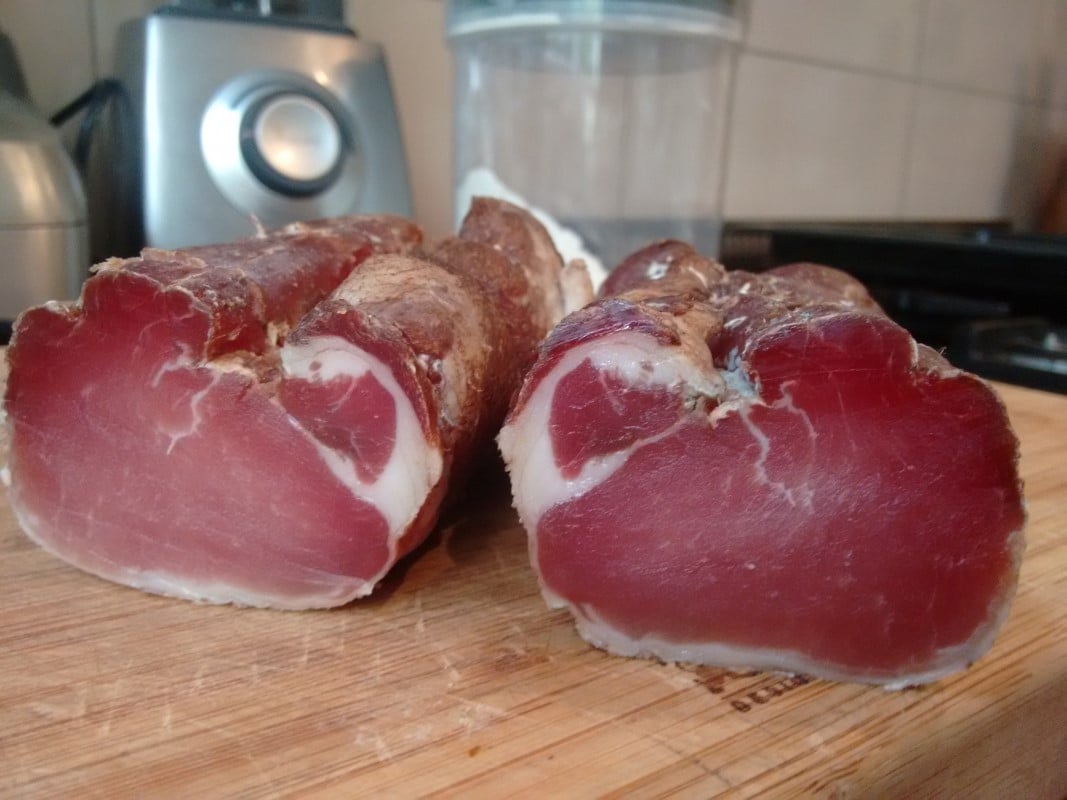
Key Ingredients
To make this recipe as helpful as possible, I’ve created a custom calculator inside the craft recipe below. This will auto-calculate the salt and spices based on the weight of the meat.
Sea Salt is essential for any curing project. For this style of equilibrium curing, it’s best to make the salt finer (I prefer powdery) and distribute it throughout the meat during curing.
If you use pink-curing salt, 90% salt and nitrates/nitrites comprise the rest. Therefore, if you want a total salt amount of 2.25%, 0.25% of this total can be the pink-curing salt.
Quality of Meat
It all starts with quality pork. Certain breeds have been made famous for dry-cured (what is dry cured link) traditional meats like Duroc, White Berkshire, and Mangalica (also known as Mangalitsa or Mangalitza). The type of pig, how it is fed, and its age are important factors.
Many black pigs across Europe are famous for Salumi (and Spain) in Italy. Often, these pigs were partially free-roaming and getting a foraged diet of wild nuts, acorns, mushrooms, and truffles (check out Umbria, Italy, for more details).
This often means the pig must be 12-14 months old. I’ve usually found 16-24 months ideal for the meat-to-fat ratio (talk to the butcher or do the research!).
From the collar/coppa cut of the loin behind this, the other loin (back steak) is used to make Lonzo.
The process of dry curing meat intensifies the meat flavor, which is why meat quality is imperative to salt dry curing.
Sugar should not be an ingredient in classic Italian salumi of any kind.
Substitutes
Since this focuses on a traditional craft recipe with hundreds (possibly thousands) of years of history, it’s not appropriate to suggest substitutions.
The Lonzino is milder with garlic and pepper. Lonzo is often spicy with adding chili/pepperocino (but in a minimal amount, 0.1-0.3% in the below recipe).
Key Equipment
For this equilibrium salt dry curing method (link to a guide I wrote), an accurate digital scale – this is a subject covered a lot on this website, here is a page on scales. It’s nearly imperative (or another form of accurate scale allowing precise measurements of one decimal place per gram).
Having an adequate-sized bag for the jowl during curing is key. The air is to be removed inside the bag. I use Ziploc bags or water bath/sous vide bags for this task. The goal is to have the meat and cure “equalizing” inside the bag.
How to make Lonzo
If need be, you trim and process the meat first. Then, the curing stage begins, which can take 1 to 2 weeks.
An optional step is to have a fermentation stage before the drying to promote lactic acid production inside the meat naturally. Often at temperatures of 20°C/70°F for 20-30 hours to achieve this. The idea being to devleop the lactic acid flavor inside the cured meat.
The drying and hanging stage applies until sufficient moisture and weight loss have occurred.
Curing Steps
Step 1
Depending on the shape of the loin, you may need to shape and trim it. Traditional, it is round or oval in shape. Some casings can make the shape more round uniform with typing.
If you wish to have more fat on the it, you can.
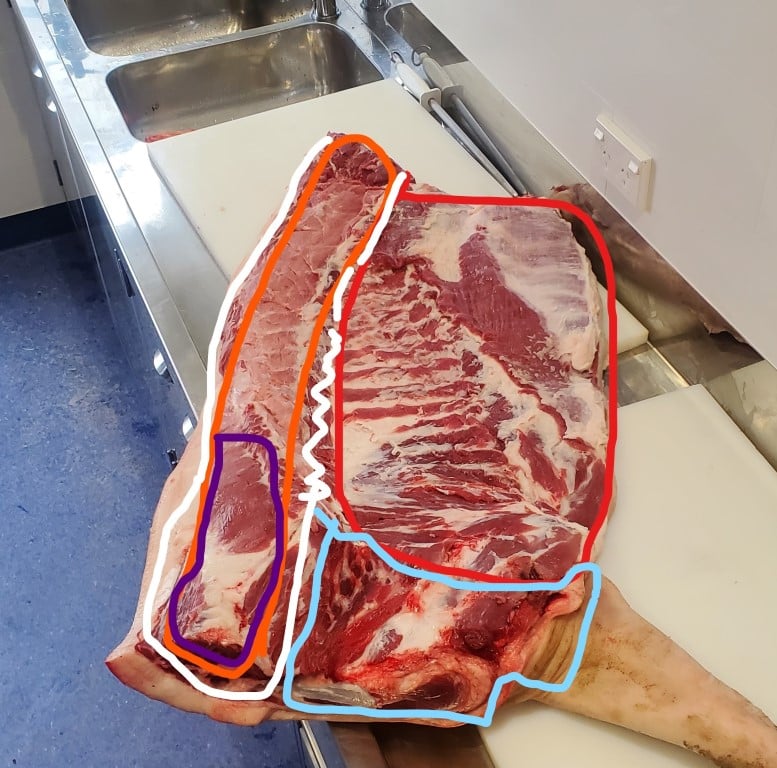
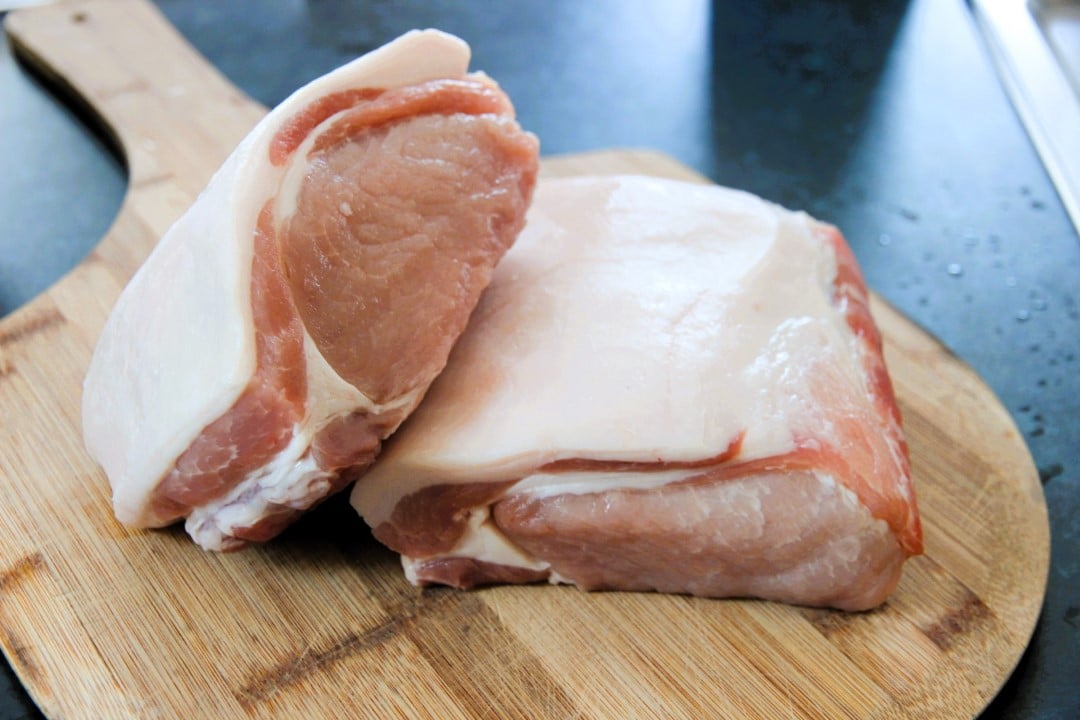
Step 2
Weighing the meat first for the equilibrium curing method, you can also record the minimum 30% weight loss needed for the drying process below. The weight of the meat can be entered in the calculator below, which will auto-calculate the spices.
If using nitrates/nitrites, accurately calculate the required pink-curing salt No. 2 (optional). No.2 Pink Curing is for meat-curing projects over 30 days long.
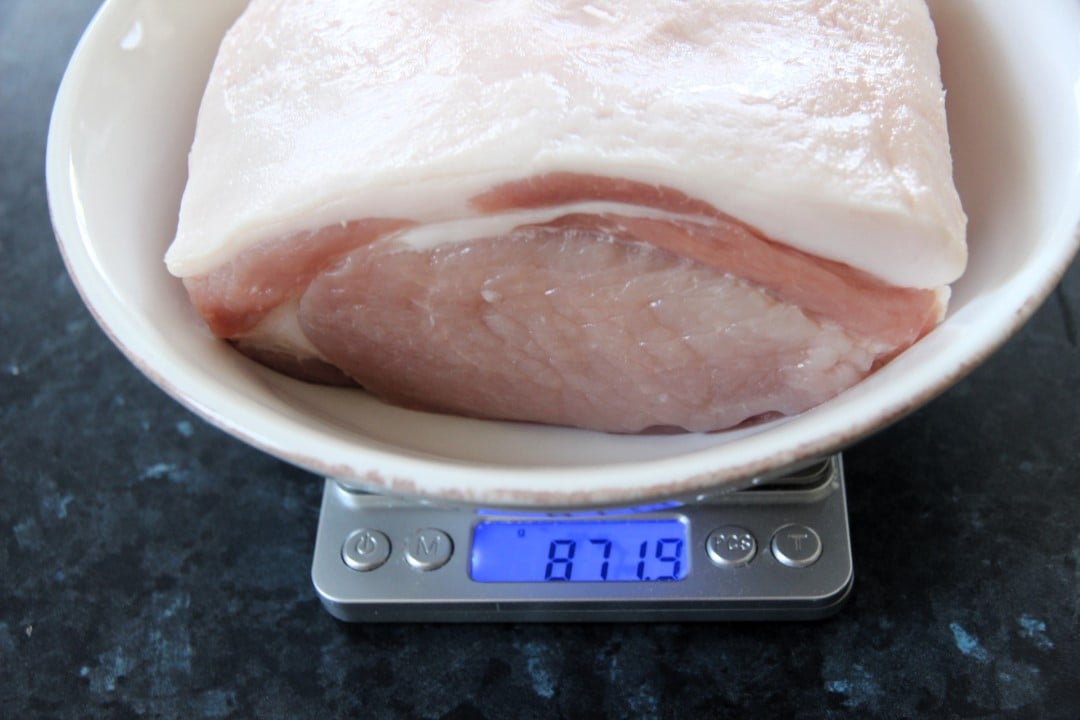
Step 3
Use a mortar and pestle or spice grinder to make the salt cure mixture finer; if it is coarse, this will help spread the mixture evenly across the meat.
Ensure there are no lumps to spice clusters in the cure mixture.
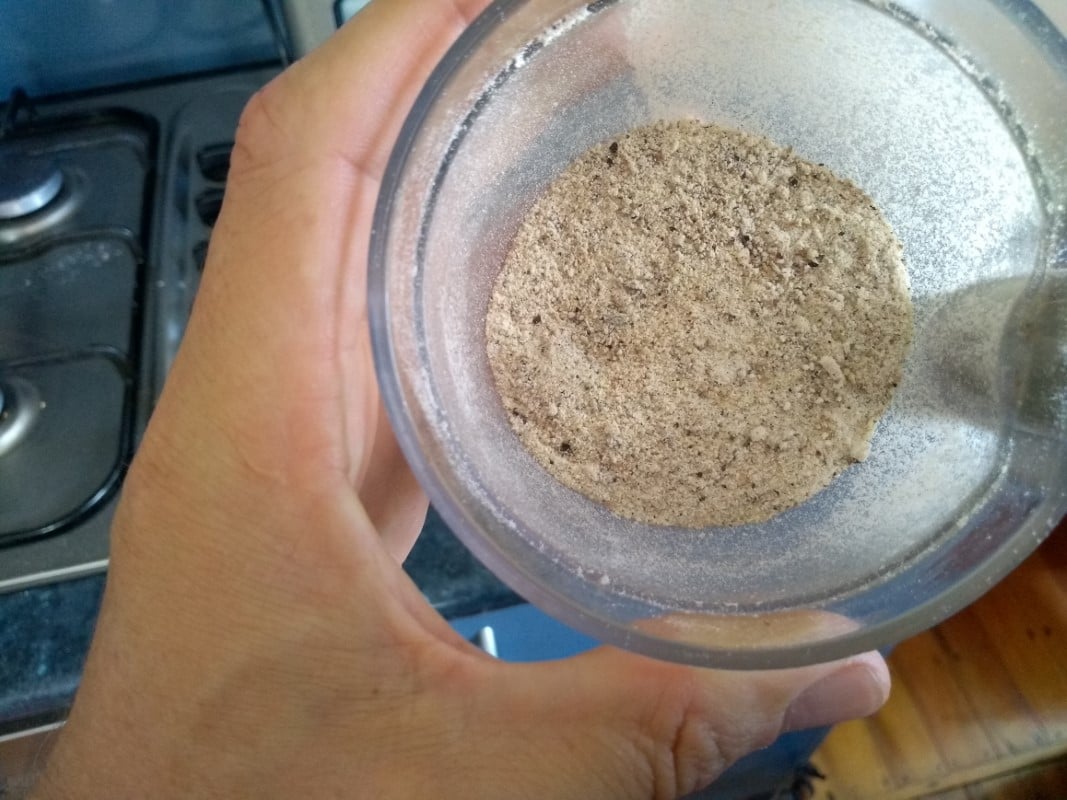
Step 4
Mix salt cure mixture, and apply to meat in a bowl or lipped metal tray.
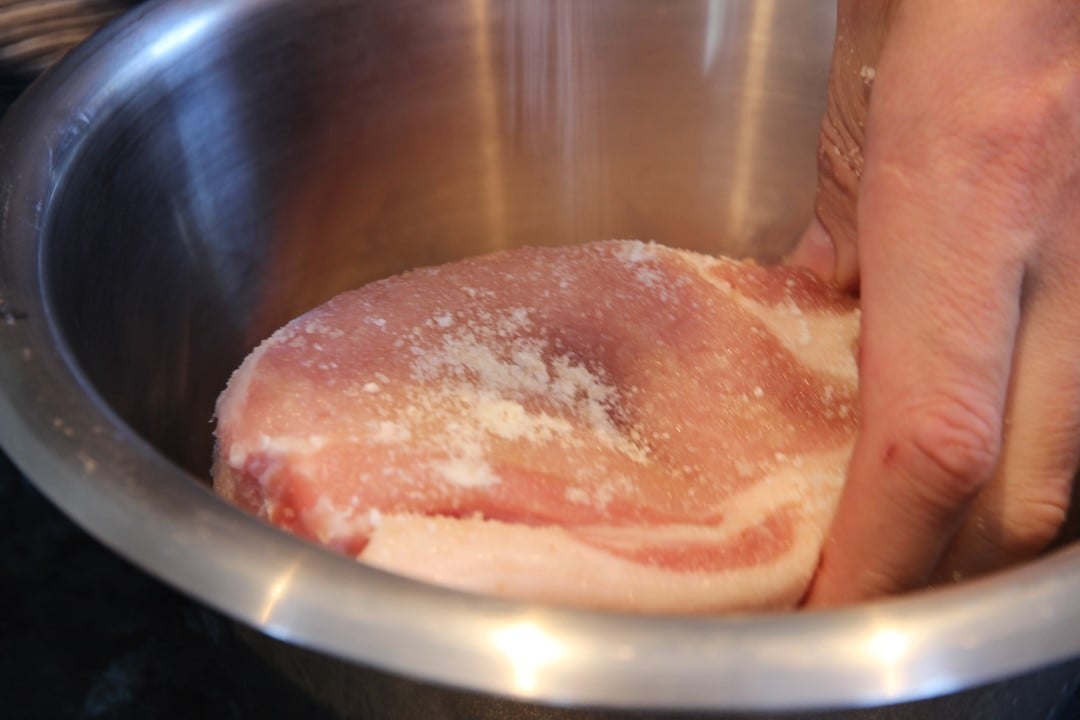
Step 5
Mix salt and cure mixture and apply to meat in a bowl or lipped metal tray. Place the meat and all the cure mixture from the bowl into a bag. Try to place all the cure mixture into the bag. You can fold the meat in the bag if you need to.
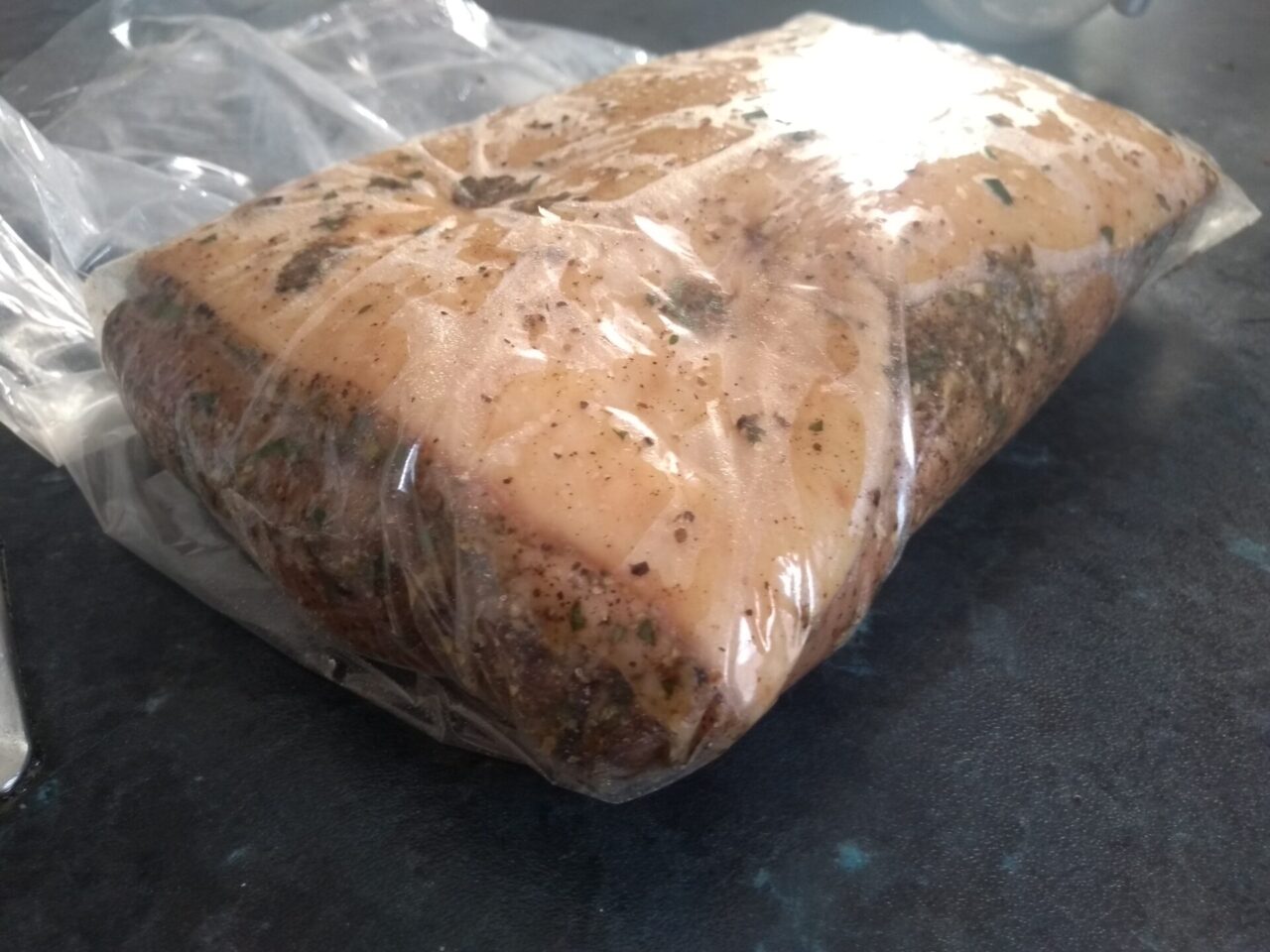
Step 6
Remove the air from the vac pac or ziplock bag; the goal is to have minimal air in the bag during curing.
Step 7
Cure in a fridge or cool area at 2-6°C or 35-45°F
Imperial – 3 Days per Inch Thickness of Meat
Metric – 3 Days per 25mm Thickness of Meat
The advantage of using equilibrium curing is that you can have the meat curing for an extra week or two. This will not increase the saltiness of the meat because it equalizes the salt content throughout the meat.
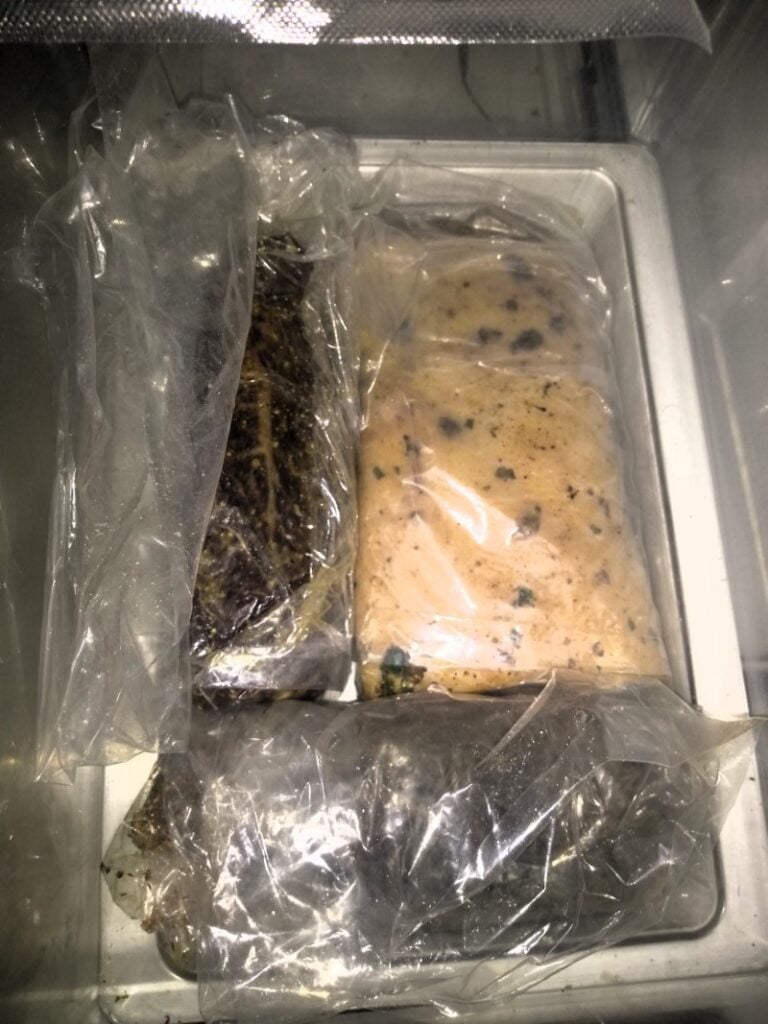
Drying Steps
Step 8
Once fully cured, remove the bag & rinse, optional, with water or wine.
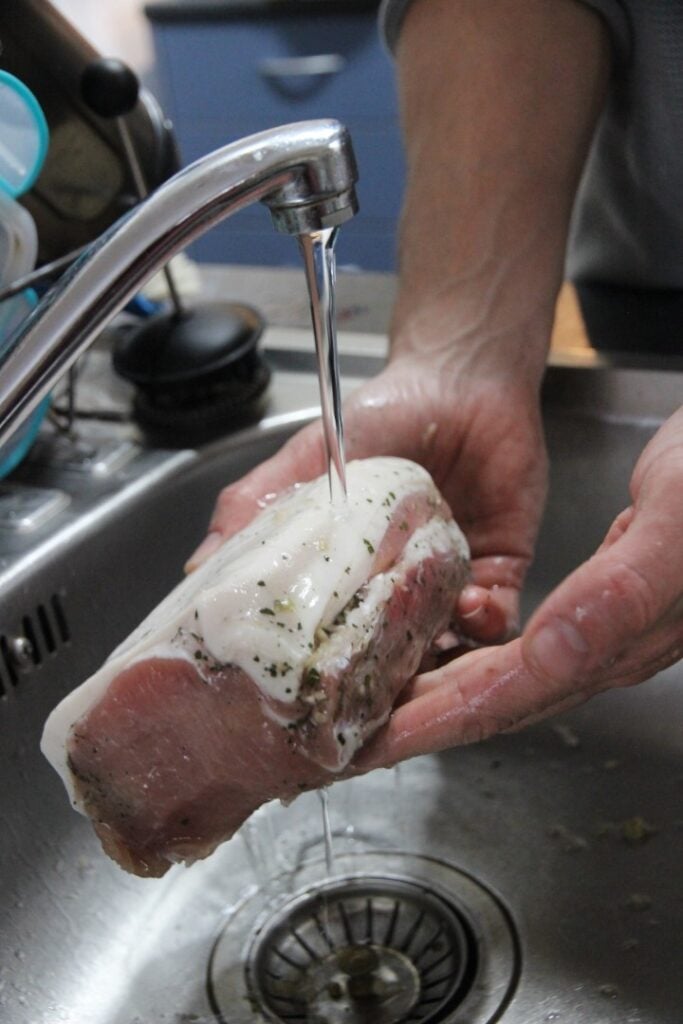
(If you forgot, weigh the meat and calculate % of the weight; this is a minimum weight loss for the finished product after hanging/drying.)
Stage 9
To hang the meat, you can tie butcher’s twine like the picture below. then a S hook or butcher twine can hang onto a rod or rack. A chopstick can be used as per the picture also.
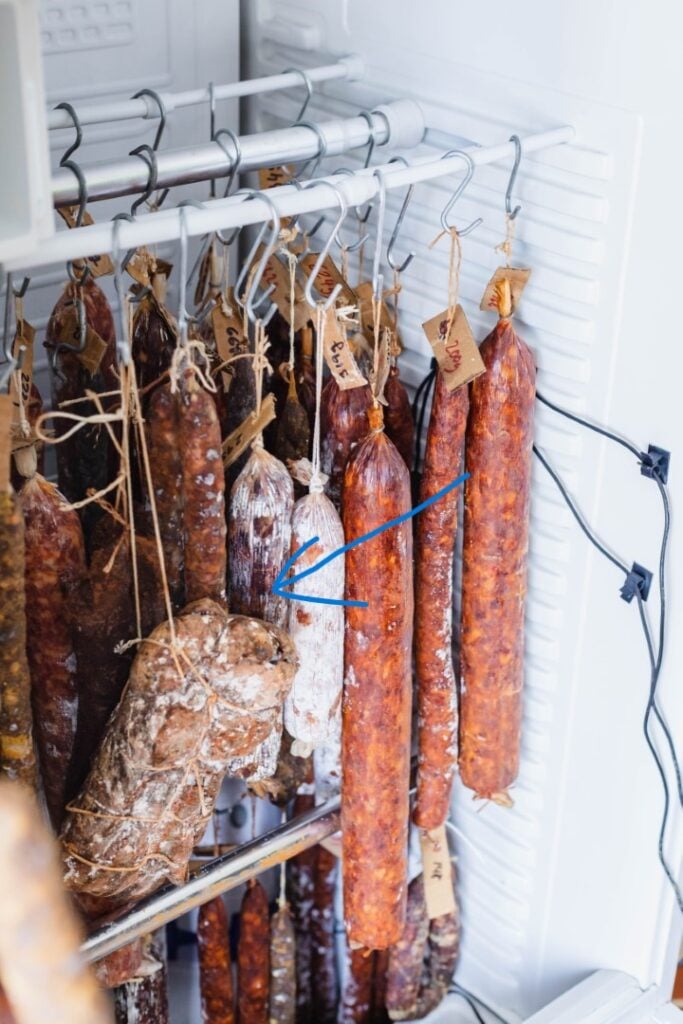
Hang the cured meat in a suitable environment. This could be a wine cellar, garage, shed, DIY dry curing chamber (article on DIY dry curing chamber here), commercial dry curing chamber, or other suitable environment
The conditions should be in this range approximately:
| Temperature | Humidity |
| 50-61°F/10-16°C | 65-80% |
You will need to check the meat regularly while it is drying. The reason for these conditions is to slowly dry the meat without drying the outside before the inside loses moisture (often called ‘case hardening’).
Airflow will also vary the speed of drying. A small amount of airflow is desirable, and ‘fresh’ air or a breeze is often preferred to avoid unwanted mold.
If too much ‘good’ mold forms, you can use vinegar to wipe or brush away the excess. For more on molds, please read this article.
Step 10
Once the weight loss is at least 30%, the dry cured meat is finished and can be eaten. Sliced wafer thin ideally!
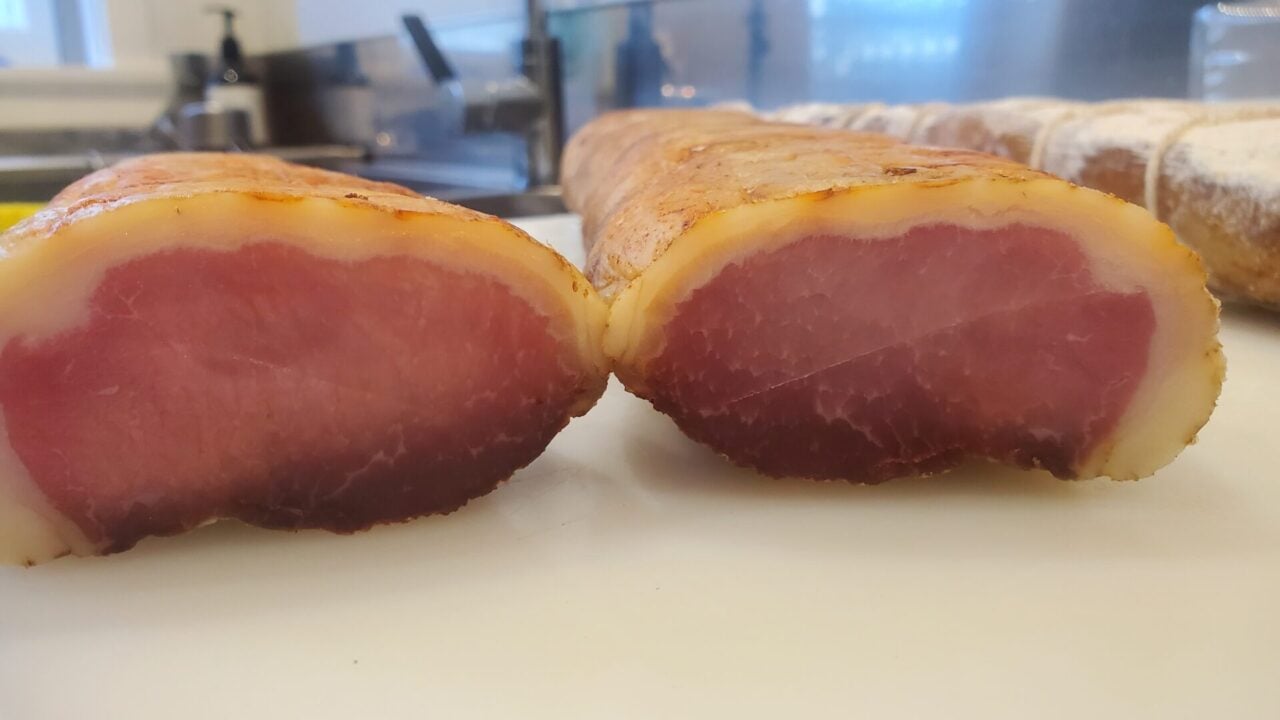
Expert Tips
- To avoid drying the exterior at the beginning of hanging, a higher humidity of 85% can be used for a few days, then reduced to approximately 70-75%.
- Before tying, a casing over the meat can prevent the outside from drying out as much. Beef bung, pig bung, or collagen sheets can be used for this.
Recipe Variations
You can vary the amount of sea salt to your preference. A minimum of 2.0% salt is needed for curing. My salt level is often 2.25% total.
The maximum I prefer for saltiness in dry-cured whole muscle is 3.0%.
What & How to Serve
- Slice wafer-thin, add to antipasti board as a starter/appetizer
Frequently Asked Questions
Difference Between Lomo, Lonzino and Lonzo
In Northern Italy, Coppa is mainly used as the name for this dry cured meat. Capocollo or Capicola are used more in Central and Southern Italy. Lomo is Spanish variation from the same cut of pork muscle.
What is Coppa Cured Meat?
Coppa is a salt dry-cured whole-muscle meat. It’s preserved with salt and dried to be shelf-stable. Subtle spices are used, such as cinnamon, cloves and nutmeg. Coppa is served by slicing very thin.
Storing and Shelf Life
The environment is cool, approximately 50-60°F/10-15°C, the finished cured meat can be hung around the kitchen. It’s preserved, so you can thinly slice for serving when wanted.
Placing it unwrapped in the fridge will speed up the drying. Most domestic fridges have a humidity of 20-40%.
Vacuum-packing and storing it in the fridge can be used for several years. I’ve had dry-cured meats in vac-packed bags in my fridge for three years.
More Craft Recipes You’ll Enjoy
Italian pancetta tesa is another classic dry-cured salumi meat with a slightly different spice mixture.
What to Expect for Serving Size
Since dry cured meat often loses 30% of its weight, it’s a more condensed form of protein. Dry-cured salumi, like this, were never produced to be eaten as a primary protein for a meal.
It’s a craft creation to be savored in small amounts. Twenty to fifty grams is plenty per person as a starter.
Scaling the Craft Recipe
You will see below the recipe has an auto-calculating recipe based on the input of the meat weight.
This will allow you to calculate the salt cure mixture. If you wish to adjust the calculation below you can also use a meat curing calculator I created on this page.
Lonza – Dry Cured (Equilibrium)
Most of the loin is used for this craft recipe. It's relatively lean compard .to other muscle groups in salumi. The spices are often simple, salt and pepper. Optionally garlic is somtimes Iincludes in Norther regional recipes. It can be trimmed down to have less fat around the outside also. It's mild and a noteworthy classic that can be eaten regularly.
Ingredients
- 1000 g Pork Loin Muscle
- 22.5 g Salt (2.25% of meat weight)
- 4 g Black pepper (0.4% of meat weight)
- 2 g garlic powder (0.2% of meat weight)
- 2.5 g Pink Curing Salt No. 2 (Prague Powder #2, Instacure #2, many other names – To be used for over 30 days meat curing projects (0.25% of meat weight) Optional See Notes
Instructions
Curing Steps
-
Weigh the meat accurately, record weight
-
Calculate or Use the Recipe Above to Auto-calculate the Salt and Spices
-
Use a Mortar and Pestle or Spice Grinder to mix the salt and spices. Mix salt, spices, and optional curing agents thoroughly, ensuring even distribution in the cure.
-
In a large bowl or tray rub and cover the meat with the salt and spices (it will seem like not much, but this is enough of the cure)
-
Apply the Cure: Coat the meat with the curing mixture, ensuring all surfaces are covered, including crevices in the meat.
-
Place the meat and all the salt cure mixture into a sealable bag- options include vacuum bags, zip lock bags etc.
-
Remove From Bag
Hanging and Drying Steps
-
Optionally, apply additional spices or aromatics before hanging – ie. chili, peppercorns
-
Optionally, Casing the cured meat before hanging using the collagen sheets then tying butcher twine around the outside sercurely. Or, using a natural intenstineca sing and tying also. Remember to price air bubble from casing with sterile needle.
-
Hang in a Suitable Environment: Place the meat in a cool, well-ventilated Area, Cellar, Garage, DIY Curing Chamber, Regular Fridge (Small Amounts), Dry Curing Chamber
-
Monitor Progress: Regularly check the meat’s weight and appearance to gauge the curing process’s progression. Vinegar dabbed onto mold can remove it, if excessive growth occurs.
-
Achieve weight loss of a minimum 30%, ideally 35-40%. However, large fat amounts have less water in regards to Weight loss.
Recipe Notes
Please note that the craft of making dry-cured meats is beyond a recipe. This is not a cooked product. It takes a reasonable amount of knowledge to safely create salumi, charcuterie, and salami.
My advice is that if you have doubts about smell or visual cues, it’s not worth eating.
This is my interpretation of a classic salumi whole muscle dry cured meat project.
- Hang the meat in a suitable environment, ensuring proper airflow and humidity levels for optimal drying.
- For small amounts under 300 grams, you can dry the meat on a non-reactive rack in a regular fridge. However, the outcomes will be far from ideal.
- If fuzzy or powdery white mold develops, you must use your senses to assess it. Here is an article about mold in detail.
- Pink Curing salt is an optional ingredient – please carefully read this other article I’ve written about this.
- If you want to build a DIY dry chamber, I’ve written extensively on the topic here.
- Always complete the drying before consumption.
- Uneven drying is always an issue with making dry cured meats after weight loss is complete. Removing the mold with vinegar, leaving it to dry in a regular fridge, and then vacuum packing for 4-8 weeks can equalize the meat moisture evenly.
Please feel free to comment or ask any questions!

Tom Mueller
For decades, immersed in studying, working, learning, and teaching the craft of meat curing, sharing the passion and showcasing the world of charcuterie and smoked meat. Read More


I always wondered and could not find a specific info about actually about cold smoking. Why the pauzes in cold smoking.
I know that not all traditional methods use a pauze and keep the smoke going. As for myself im sort of in between i keep it going but there are interval of 2 a 3 hours pauze because the smoke has than gone out in the night. But than in the morning i fire it back up.
For example i see some folks do maybe 3 hours of smoke with 3 hours pauze and to this 3 times and they already get a color on the meat. For me i have to at least smoke it min 3 days and on the 3th day the color starts to come. As in my environment i also noticed that the longer the smoke the better i can preserve it and prevent hairy molds or colored molds usually because of the high humidity all the time. I usually store it in my basement but when late spring and summer comes i vacuum everything and store it in the fridge because than the basement gets to around 20 a 25c
Also if i only smoke 3 or 8 hours the smoky taste isnt just their its very light and the next day it almost gone or very lightly present.
Im from the Netherlands btw i read that you worked or studdied with a Dutch buther i wonder where did you do this in the Netherlands just out of curiosity. Best Regards Stuart
Hi! I learnt from a Dutch Butcher here in New Zealand 🙂 He had a large iron smoker shed, and lit saw dust on the floor. Every cold smoker setup may act differently, also the external environment, moisture/humidity and temperature will also effect it. I’ve always found the pause/pauze develops the flavor more. For instance, cheese, 1-2 hours – taste it immediately its not very smokey, place in container overnight, completely different. Lighter smoke over longer periods of time (8-10 hrs) could be similar to thicker/stronger smoke over 4 hours. The in and out flow of air is also a factors. As well as how dry the outside is (pellicle). If the humidity it too high in an environment, I’ve found the pellicle does work as effectively. All the best Tom